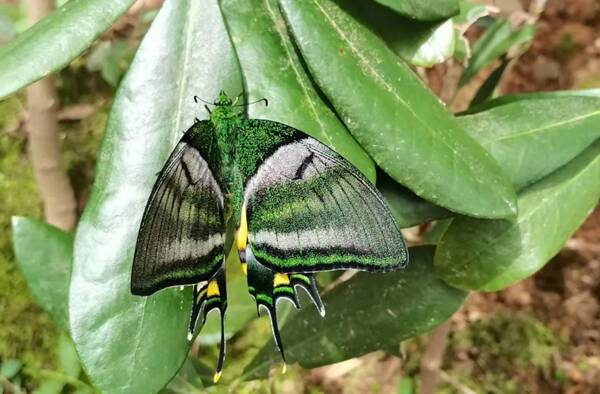Teinopalpus aureus
IUCN
LCBasic Information
Scientific classification
- name:Teinopalpus aureus
- Scientific Name:Teinopalpus aureus
- Outline:Arthropoda
- Family:Lepidoptera Papilionidae Papilio
Vital signs
- length:About 30 mm
- Weight:
- lifetime:
Feature
The golden-spotted swallowtail butterfly has a graceful flying posture, like a gorgeous, noble and radiant "lady", so it is called the "Queen of Butterflies" and is a precious butterfly species in the world.
Distribution and Habitat
The Golden Swallowtail is a species endemic to China and is also the most valuable and extremely rare butterfly in the world. It is extremely rare and is distributed in Guangxi, Guangdong, Fujian, Zhejiang, Jiangxi, Hainan and southern to southeastern Yunnan.
It lives in evergreen broad-leaved forest mountains at an altitude of about 1,000 meters.
Appearance
The Golden Swallowtail is a large swallowtail butterfly. Its wing scales shimmer with a faint green light. There is an arc-shaped golden green band on each forewing; there are several golden yellow spots in the center of the hindwings, and there are crescent-shaped golden spots on the rear edge. The tail-like protrusions of the hindwings are slender, with a small section of golden color at the end. The Golden Swallowtail is a large swallowtail butterfly with a mostly green body and a golden tail protrusion. The forewings are about 55 mm long, with a black wing surface covered with dense, shiny green scales and a black band with a bright yellow-green edge at one end. There is a large golden spot in the dial area of the hindwing, and some blue-black, orange and green bands crossing the spot.
Details
As a unique treasure of China, the Golden Swallowtail is known as the "national butterfly" and the "pride of butterflies". It is precious and rare. It is the only butterfly in China that is under national first-class protection. It ranks first among the eight precious butterflies in the world. It is also known as the "dream butterfly" and the "living fossil of the world's animals".

The Golden Swallowtail is a subtropical and tropical alpine species that likes to suck the nectar of a plant of the Ericaceae family. It often flies high in the sky in the forest, and sometimes stops among the flowers. Its posture is graceful, gorgeous, noble, and dazzling. It flies quickly and rarely stops to rest. It often flies in circles on the treetops, sometimes rushes down to the ground to visit flowers and absorb water, and then immediately rushes into the sky.

There is quite limited information about the two generations of the Golden Swallowtail butterfly in one year, the short activity time of adults, and the great influence of climate on mating and reproduction. In addition, the ratio of females to males is very different (1:50~200), so it is difficult to see female Golden Swallowtail butterflies.

The peak mating period of the Golden Swallowtail is August 28. First, individual male adults appear, then the number of males increases, and they fly quite actively. Later, female adults appear. Before mating, the male and female chase each other and fly straight and fast into the sky. The Golden Swallowtail hibernates as pupae. The overwintering pupae will not emerge until late April to early May of the second year. The adult period is very short, only more than 20 days, during which time the male and female butterflies must complete mating. Its eggs hatch into larvae in mid-May, and the larvae pupate in July. The pupal period is very short, and it will emerge as a butterfly in early August and mate and lay eggs. Then it will also go through the egg and larval stages, and turn into overwintering pupae in September and October. The overwintering pupae have to endure the long winter and wait for the spring flowers to bloom next year.
Listed in the International Committee for the Protection of Endangered Species of Wild Fauna and Flora: R level (the rarest level).
Listed as a first-level protected species in the Convention on International Trade in Endangered Species of Wild Fauna and Flora (CITES).
Listed as a first-class protected animal in the "National Key Protected Wildlife List" of the State Forestry Administration of China.
Listed in the 1996 Red List of Endangered Species of the World Conservation Union (IUCN) ver3.1-Data Deficient (DD).









